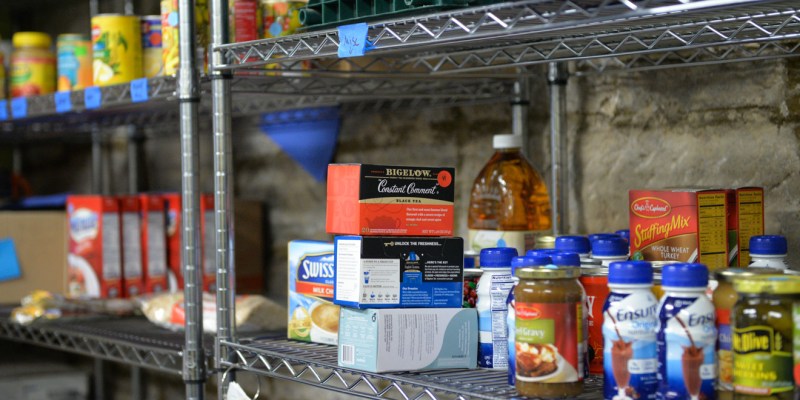After finishing a shift at Market Central, Alexandria Dsouza usually swings by the Pitt Pantry to pick up her groceries for the week.
“I come here primarily for toiletries, like toothpaste and toilet paper, and breakfast foods like bagels and cereal,” Dsouza said, leaning comfortably against the pantry doorframe, a bag of bagels firmly cradled in the crook of her elbow. “And beans. Beans are great.”
Dsouza, an international student from India, lives off campus in the Shadyside neighborhood. Since getting to the University of Pittsburgh in August 2016, she has been visiting the pantry to save her wages for rent, tuition and additional costs that inevitably crop up.
“Every little bit helps,” Dsouza said. “Most of the money I make working at Market Central goes toward my rent and other expenses. Any chance to save cash makes a difference to me because I’ve taken on a lot since arriving here.”
The Office of PittServes — which connects students with service opportunities — facilitates the non-profit, volunteer-run Pitt Pantry. The Pantry takes donations from individuals, food drives and food recovered from businesses including Starbucks and Einstein Bros. Bagels. It also receives cheap and healthy recipes from the Greater Pittsburgh Community Food Bank.
“We’ve had tremendous support from the local community,” Smith said. “Sometimes we’ll get food from drives we didn’t even know were held.”
Tucked away in a corner room of the Bellefield Presbyterian Church’s basement, the pantry is not a permanent structure and is only open Wednesdays from 5 to 8 p.m., Thursdays from 1 to 4 p.m. and Fridays by appointment. Colorful paper decorations hang from the ceiling and brush shoppers’ heads as they follow their pantry guide — a student volunteer — to the beat of pop music playing in the background.
Healthy, easy recipe ideas dangle over collapsible shelves housing perishable items. Next to a refrigerator stocked with yogurt and salads is a folding wall decorated with tacked-on coupons.
Junior Madoc Smith — one of three or four student volunteer workers on duty at all times — escorts individual shoppers through the pantry during a shift in February, asking about their allergies and diet and if they own a can opener or microwave. If needed, the mathematical biology, computer science and urban studies major directs them to the vegetarian or gluten-free sections.
“The people who come in here, they’re just kids trying to eat,” Smith said. “We try to make it as welcoming an experience as possible.”
As Smith guides a shopper through the pantry, he tells them how much food they’re allowed to take. Pantry customers are allowed to make two visits a month and must fall under the United States Department of Agriculture’s federal income eligibility guidelines. The income limit is $17,820 for an independent individual, $24,030 for a couple and $36,450 for a family of four. The amount of food a customer is permitted to take depends on how many people they’re shopping for. For instance, a person shopping for just themselves may take one can of soup, but a person shopping for three people may take two.
“We try to supply students with aid beyond just giving them food,” Smith said. “We’ll also hold home winterizing workshops and do stuff like send them information about stores holding sales.”
At a University that costs upwards of $17,000 a year, or more than $28,000 for out of state residents, a food pantry seems like an ironic necessity. But it might be the high — and rising — cost of college, along with all the added costs of living, that make it so needed.
The Pitt Pantry’s customers are only a handful of the thousands of college students who visit campus food pantries across the U.S. — and that number has ballooned in recent years. The College and University Food Alliance welcomed its 400th food pantry in December 2016, a large increase from its original 13 college pantries in March 2012.
The October 2016 report Hunger on Campus surveyed more than 3,000 students at a mix of 34 community and four-year colleges and found that 48 percent of recipients experienced food insecurity in the past month, having to skip meals or shorten meal sizes because they lacked funds.
Of the food-insecure students in the study, 32 percent said that hunger problems had an impact on their education — 53 percent of those respondents reported missing a class, and 25 percent reported dropping a class due to food insecurity.
During its first month, 23 people visited the Pitt Pantry. Now nearly two years old, the pantry serves between 50 to 100 members of Pitt’s faculty, staff and student body a month.
An undergraduate Pitt student and visitor to the Pitt Pantry who wished to remain anonymous said she attends the pantry because she can’t risk asking relatives for spare funds and what money she makes must be put towards other expenses.
“I don’t want to bother [my mom] for cash for food while she’s got her own expenses to cover,” the student said. “All the cash I make over the summer I use to pay my rent.”
The student said she doesn’t think people realize just how many people benefit from the Pitt Pantry’s presence on campus and how much its services mean to many students.
“It’s definitely the best program Pitt has to offer — after all, everyone needs to eat dinner,” the student said.
A longer version of this article was written for The Pitt News as part of Impact Journalism Day, an initiative spanning over 20 schools from the around the world that showcases college students’ work on social and environmental problems. To mark Impact Journalism Day, The Daily is featuring stories from other participating college newspapers.
